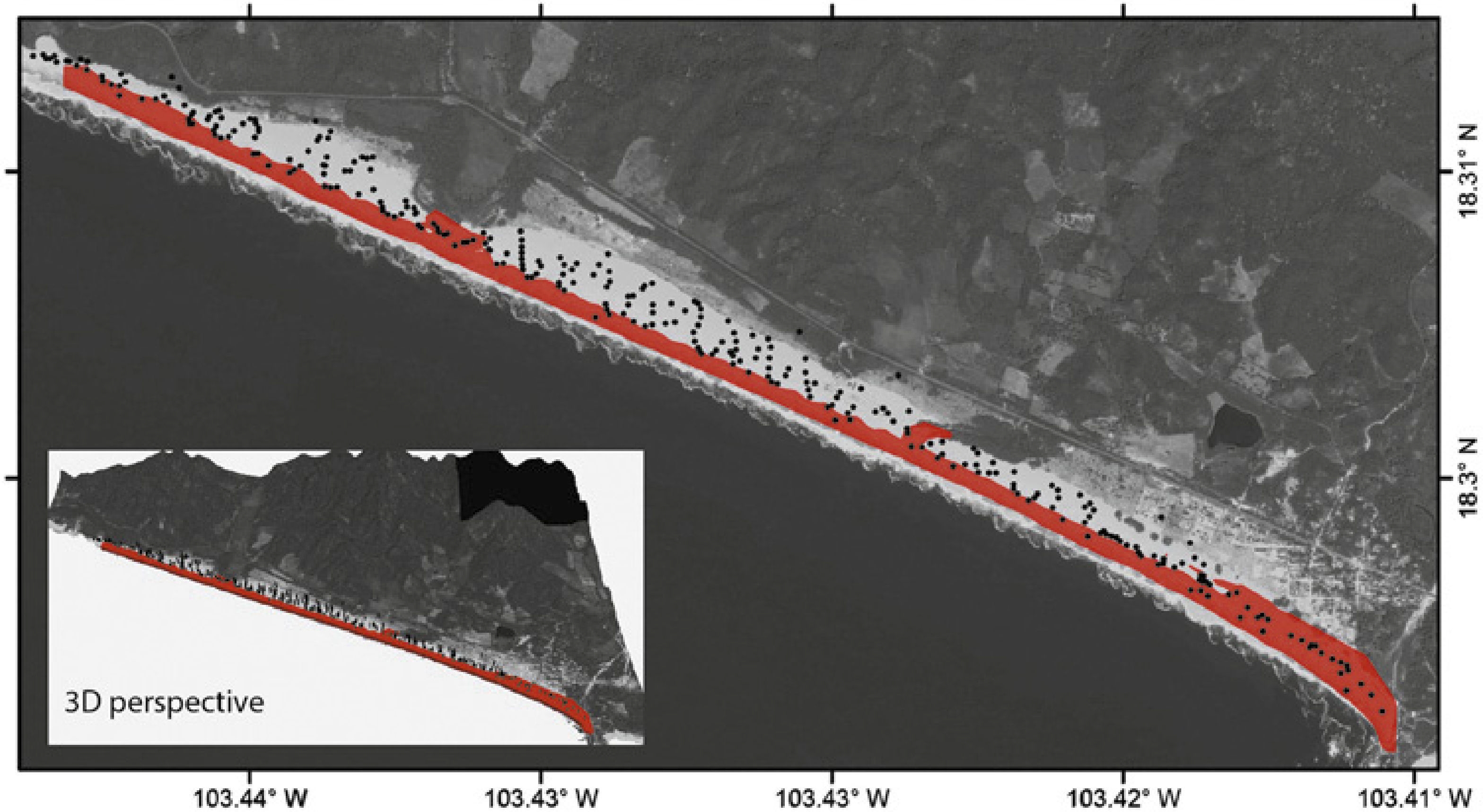Introduction
It is expected that climate change will directly affect individual organisms, populations, species distribution and ecosystem function (IPCC, 2002). The rise in sea level is probably the most important anthropogenic effect of climate change in the present century (Grinsted et al ., 2009). It threatens to inundate and erode beaches, i.e. the principal nesting areas of sea turtles, where infrastructure or natural obstacles hinder the landward retreat of the beaches (Drews and Fonseca, 2009).
The life cycle and biology of sea turtles are closely linked to their terrestrial environment. Changing conditions in nesting and foraging beach areas, which can limit their potential for growth and reproduction, are severe threats for populations that are already under pressure at the global level owing to high mortality as a result of fisheries, over-exploitation and habitat modification (Lutcavage et al ., 1997).
Sea turtles are an ancient species group whose adaptive capacity is determined by the speed and geographic scale at which their environment changes. True, they survived the four great glaciations of the Pleistocene and many other, albeit lesser, events that caused the extinction of the great mammals, and they have retained physiological mechanisms that have allowed them to mitigate the effect of events whose cycles are of short or medium term. However, the likely effects of processes associated with the present accelerated increase in temperature are unknown.
In all sea turtle species, reproductive success depends mainly on the availability of terrestrial habitat. Sea turtles can emerge onto the beaches to deposit several batches of eggs during the course of a nesting season (Miller, 1997). The loss of beach nesting habitat up to 2080 through a sea level rise of 4.2 mm per year suggests potentially adverse effects on their reproductive success and hence on their survival (Church et al ., 2001; IPCC, 2007).
Sea turtle species are of interest for conservation and they are increasingly seen to be affected by a series of natural and anthropogenic hazards. However, despite the many efforts in the past two decades to understand and mitigate the threats to these turtles (Lutcavage et al ., 1997; Watson et al ., 2005), until recently little attention has been paid to the threat posed to this group by climate change (Mrosovsky et al ., 1984; Davenport, 1989).
The place where the turtles make their nests can affect their reproductive success: the fitness for survival and the success of their progeny (Bjordal and Bolten, 1992). Although it is not entirely clear why some beaches are favored by turtles for egg-laying, Mortimer (1982) identifies the following general requirements for a nesting beach.
1. The beach must be accessible from the sea.
2. The beach must be high enough to prevent the inundation of the eggs through wave action or through a rise in the water table.
3. The substratum must allow the diffusion of gases.
4. The substratum must be humid and sufficiently fine-grained to prevent the collapse of the nest chamber during its construction.
The slope of the beach is a function of various factors that include the geomorphology of the zone, wave action, storms and the grain size of the sand (Bird, 1996). The rise in sea level and an increase in the frequency and intensity of hurricanes will increasingly affect beaches.
Studies of changes in sea level through global warming predict a range of scenarios. Rises of 0.18 to 0.59 m are expected by the end of the 21st century (IPCC, 2007). A rise in temperature of between 1.5° and 5 °C will bring a possible rise of 0.20 to1.65 m in sea level (Lara, 2008). Predictions have included a rise of 0.75 to1.90 m for the period of 1990 to 2100, (Vermeer and Rahmstorf, 2009), of 0.26 to 0.39 m by 2025, and of 0.91 to 1.36 m by 2075 (Hoffman et al. , 1983).
The World Wildlife Fund (Fish and Drews, 2009) estimates that climate change will adversely affect marine turtle populations as follows:
1. Mortality of the young through desiccation or flooding of the incubatory substratum through a rise in the water table.
2. Loss of the nesting habitat through erosion and sea inundation of the beaches.
3. Distortion in the sex ratio of the young, through failure to produce males.
Studies of sea-level rises on beaches used for nesting by marine turtles (Delgado and Alvarado, 2005) have shown a loss of ∼70% of the reproductive population of the black sea-turtle (Chelonia agassizi =Chelonia mydas agassizi ), also referred to as Eastern Pacific green turtle, a species classified as endangered (World Conservation Union, 2001). The Official Mexican Norm NOM-59-SEMARNAT (Official memorandum 6 March 2002) lists it in the category "in danger of extinction". Sea turtles are of great tourist economic value and are highly vulnerable to human activity, at least during nesting. Their inclusion in most lists of threatened species or those in danger of extinction reflects their over-exploitation by humans (Pritchard, 1997).
In Mexico, the loss of nesting habitat through rises in mean sea level has not been evaluated. Models of local beach inundation by sea-level rise are important in determining the risk; the present study is one of the first attempts to test it in Mexico. This study considers a range of scenarios involving sea-level rise caused by global warming, and evaluates the likely effects of the loss of beach nesting habitat in Colola Beach, Michoacán, Mexico.
Study area
Colola Beach (18°17¿47" N, 103°24¿3" W) is the principal nesting area of the black turtle (Chelonia mydas agassizii ). It is located along the Pacific coast of Mexico, a tectonically active coast. The Pacific coast in Michoacán is bordered inland by rough topography of the folded and fault-blocked mountains of the Sierra Madre del Sur and by narrow beaches (Figure 1). Colola beach is 4.8 km long and an average 150 m wide, reaching more than 200 m width in some sectors. It extends in NW-SE direction, with two minor rivers (arroyos) flowing to the east and west of the beach, and a rocky granite outcrop defines its western end, while the village of Colola is at its eastern end. The beach sand here is relatively coarse grained and the most abundant minerals include biotite, magnetite and zircon (Alvarado and Figueroa, 1989). The Colola beach morphology is characterized by a steep slope (Figure 1). Although the beach morphology is highly dynamic and its characteristics change seasonally, we summarize here the general characteristics of this beach. The lower and seaward sector of the beach, the beach face, is steep and shows variable slope, ranging from 10° to 30°; it remains wet because of the influence of waves depending on the month of the year, when wave conditions, wind direction and intensity change. Landwards and up-profile, the backshore, shows a berm, characterized by a gentle slope, and marks the boundary between beach face and the beach mid-platform. The beach mid platform is flat and is the most extensive area barren of vegetation. Above the mid platform, there is an area with gentle slope and patches of vegetation (Distichlis spicata and Ipomoea pes-caprae ) (Perez, 2008). The higher area of the beach is the upper beach limiting with the vegetation. The predominant vegetation is low deciduous forest, medium semi-evergreen forest, mangrove, bushy scrub of coastal dunes, and palms (Alvarado and Huacuz, 1996). Climate is warm humid with storms and strong winds and rainfall during July-October, and a prolonged dry period from November to July (Alvarado and Huacuz, 1996). Major hurricane and tropical storm activity prevails during June to November in the Eastern North Pacific (NHC, 2013). The black sea-turtle breeding season coincides from August to March, with the hurricane and tropical storm activity, which suggests that morphologic changes along-beach and on the beach profile occur seasonally. Two zones are favored for turtle nesting: the middle zone of the beach profile, around100 m from the beach tide front, and alongshore on the western and central sectors of Colola beach (Fuentes et al ., 2010).
Methods
Digital elevation model
The elevation of the terrain was determined by surveying the topography of Colola Beach with a SOKKIA total station SET 630RK. Data were recorded with vertical and horizontal accuracy of 3 mm from equidistant points at >11 m and maxima of <40 m distance, and random points with known elevations (Weibel and Heller, 1991). The coastline was plotted by visual interpretation from a Google Earth satellite image for October 31, 2005 (Google Earth, 2011).
Interpolation
The collected three-dimensional coordinates were imported in the ArcGIS environment (ArcGIS, 2013) and plotted to a ground control points shape file. The ground control points were used as sample points to generate a 20 cm pixel size digital elevation model (DEM). The DEM was generated by the interpolation method known as inverse distance weighting (IDW) using the Topo to Raster tool in ArcGis. This is a local deterministic interpolation technique that has been found to be good for interpolation of geomorphologically smooth areas and is as accurate as other interpolation techniques (Aguilar et al ., 2005; Arun, 2013). This interpolator assumes that each point in the data set has a local influence that decreases with distance, and hence the values of the points near the node that is processed have more importance or weight in the estimation of the value that will be assigned to it, than have the points that are further away (Burrough and Mcdonnell, 1998). Normally, the search is made considering a number of points or a radius (in a circle around the cell under consideration).
Once the digital elevation model had been obtained, we simulated possible sea inundation of Colola Beach under three different scenarios of sea-level rise (0.50 m, 1.40 m and 5.0 m) based on present predictions of 0.5 m within the next 50 years and of 1.40 m in 100 years (Vermeer and Rahmstorf, 2009). The 5.0 m sea level rise is a hypothetical scenario with no precise date of when it might happen.
Position of individual nesting sites
The black sea-turtles nest mainly in the mid platform of the beach, which is a warm area far from the high tide mark and free of vegetation (Pérez, 2008). To plot the spatial distribution of the turtle nests, we sampled 300 nests with a portable global positioning system (GPS Garmin) along the length of the beach and across its width. The positioning of these points was superimposed on the inundation models to determine the probable impact of sea-level rise under the different scenarios proposed. Topographic profiles across the Colola Beach and the beach areas lost due to possible inundation scenarios were measured using the DTM.
Results
The DEM, topographic profiles, and plot of nesting sites in the Colola Beach show that most of the nesting sites are located in the mid-and high-beach. The beach slope although variable alongshore, tends to be steep (10° to 30°) in the beach front facing the sea (Figure 2). The effects of different sea-level rise scenarios and inundation of the beach are illustrated on six crossed beach profiles traced from west to east on Colola beach (Figure 2). It is evident that the effect of a 0.5 m sea level rise is apparently smaller along shore. While a sea level rise of 1.4 m would affect mostly the foreshore along the Colola beach. Instead, a sea level rise scenario of 5 m would have a significant flooding effect in the beachfront and mid-platform of most of Colola beach, with more dramatic effect on the westernmost and easternmost sectors of this beach (Figure 2).
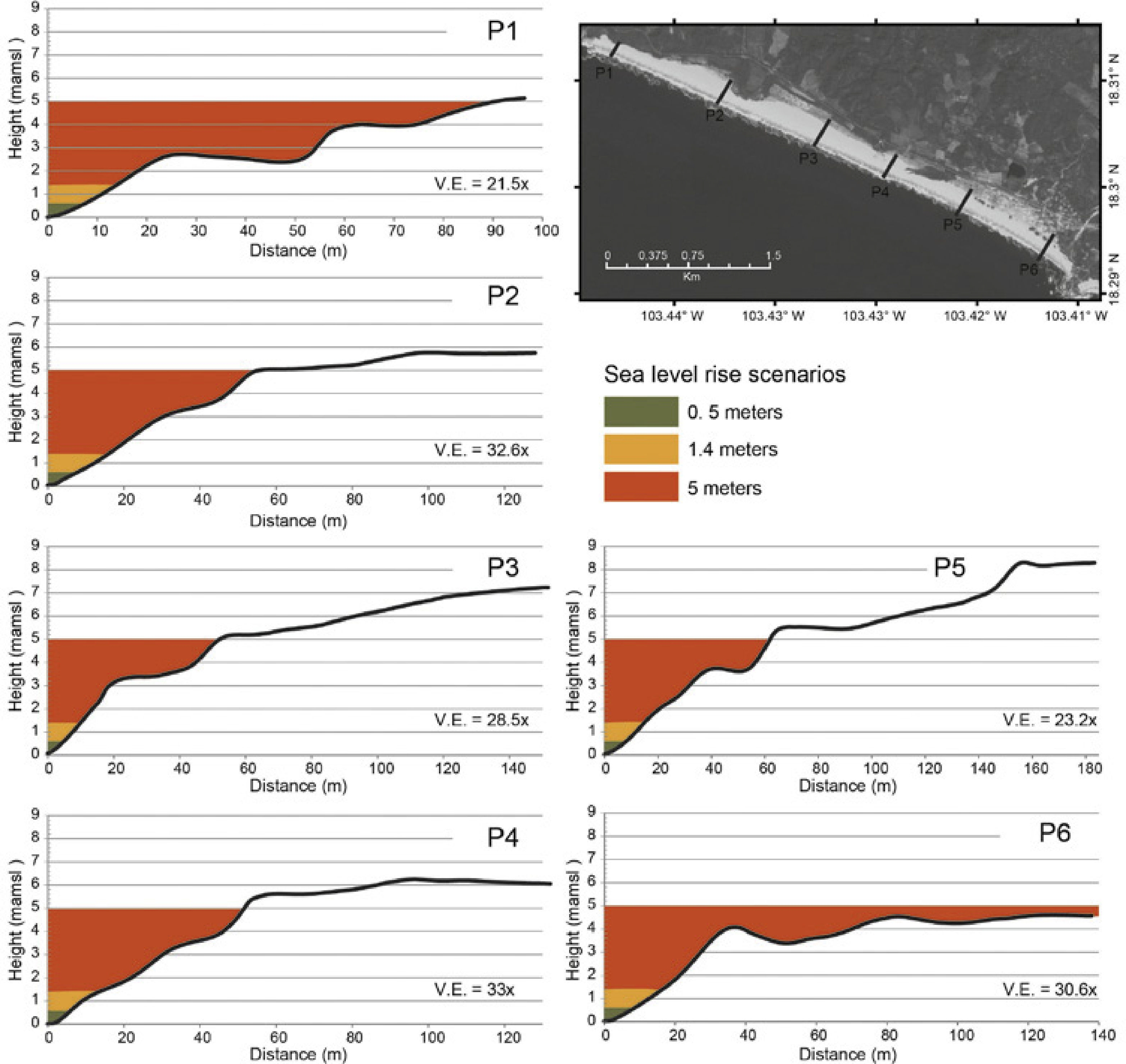
Figure 2 Topographic profiles of Colola Beach. Symbols: mamsl-meters above mean sea level; V.E. - vertical exageration.
The simulations of beach inundation in Colola suggest that a rise of 0.50 m in sea level, predicted to occur within 50 years (Vermeer and Rahmstorf, 2009), would affected the beachfront and produce 2% of area lost (Table 1). Although variable, the steep beach profile (10° to 30°) in the lower and seaward sector of the beach, the beach face, prevents from a larger damage and loss of the sea-turtle nesting area (Figure 3).
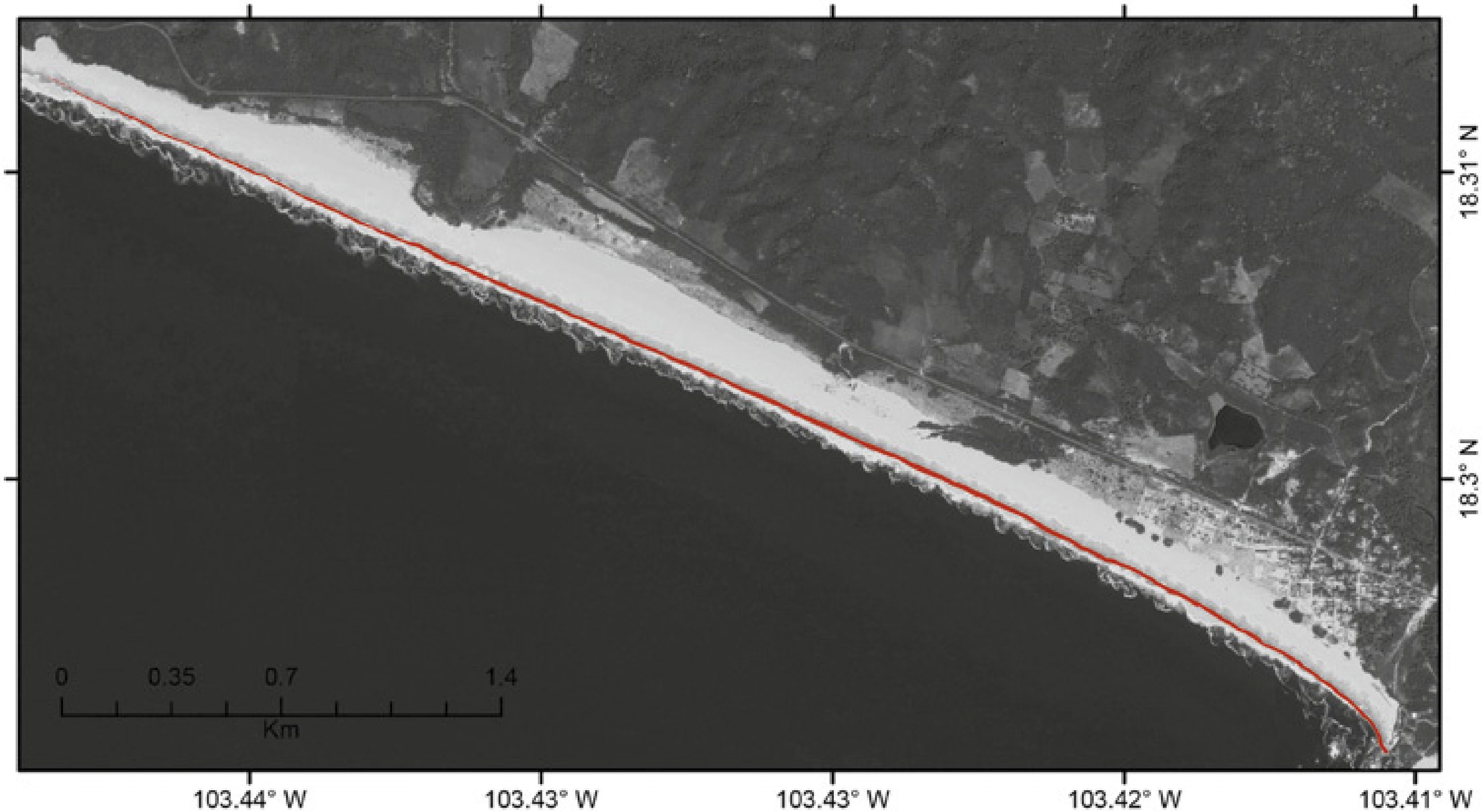
Figure 3 Model shows a sea-level rise scenario of 0.50 m at Colola Beach, Michoacán, Mexico, as predicted within 50 years. Inundated areas are shown in red color.
Modeling of a rise in sea level of 1.40 m, predicted for the next 100 years, suggests a significant loss of beach area (9%). Since the black sea-turtle tends to nest in the mid-and high-beach, the steep slope of the beachfront aids in preventing a major loss of nesting area (Figure 4, Table 1).
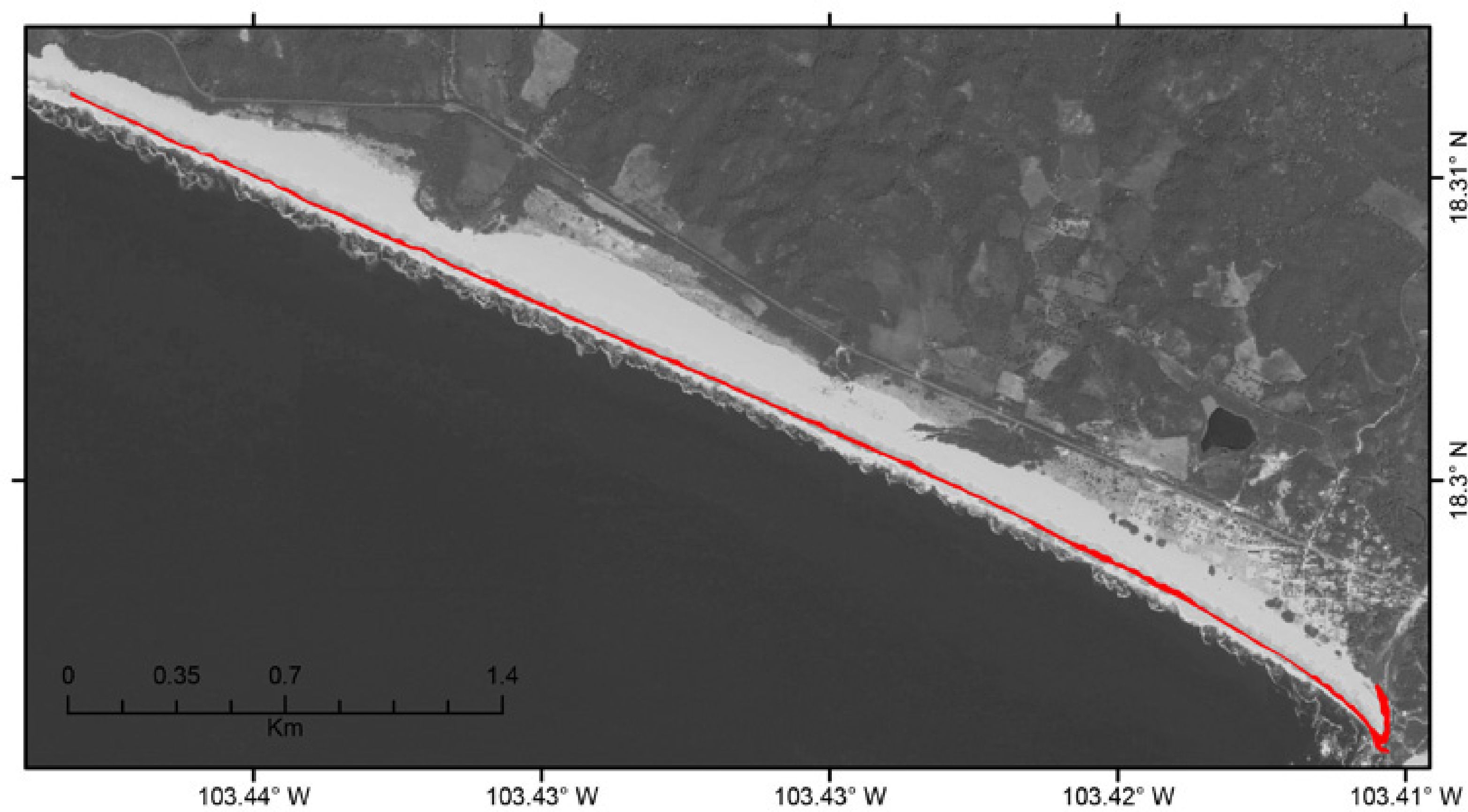
Figure 4 Model shows a sea-level rise scenario of 1.40 m at Colola Beach, Michoacán, Mexico, as predicted within 100 years. Inundated areas are shown in red color.
The model of beach inundation by sea-level rise of 5 m shows a considerable loss of beach, sparing only isolated patches. Two rivers reach the sea at Colola Beach, and the rising seawater would encroach on their channels and thereby leave the turtles with practically half of the current nesting area (Figure 2 and 5 ). The projected loss of beach area is about 54% (Table 1). Although in this scenario some nesting individual sites would not be affected, the main nesting area, in the mid platform of the beach, would be completely lost (Figure 6). Since Colola is a wide beach (150 m average width), only those areas landwards and near the vegetation would be the least affected, but high tides and the proximity of the coastline would result in deleterious effects in these areas also (Figure 5).
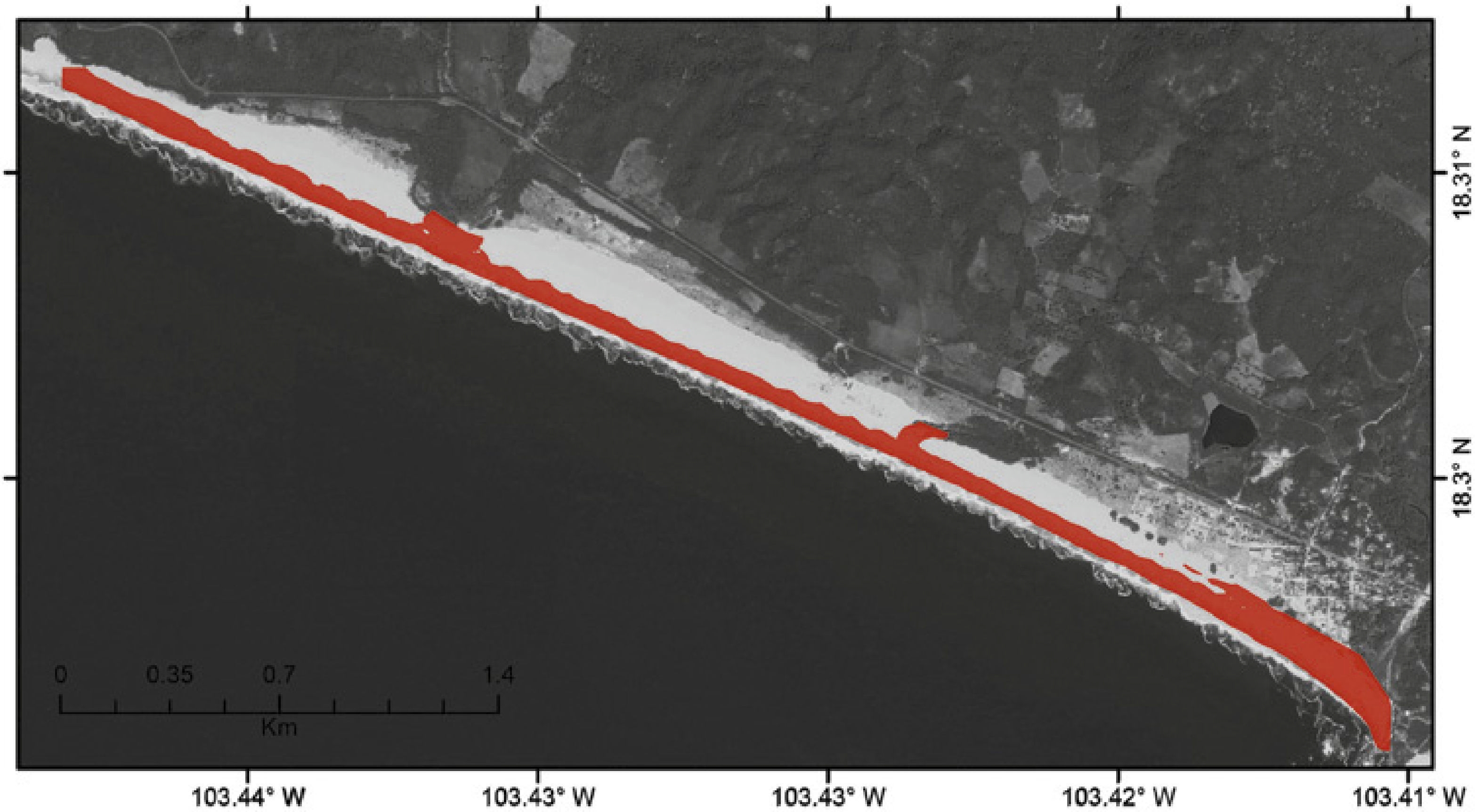
Figure 5 Model shows a sea-level rise scenario of 5 m at Colola Beach, Michoacán, Mexico. Inundated areas are shown in red color.
Discussion and Conclusions
Tectonic uplift vs. sea level rise
The Michoacán coast is located in a tectonically active margin. This coast is subject to tectonic uplift (Ramirez-Herrera and Urrutia-Fucugauchi, 1999, Ramirez-Herrera et al ., 2011). The estimated rate of coastal uplift, based on marine terrace ages, for the neighbor areas in Michoacan-Guerrero coast is ca. 6.6 +/- 2 m/ka (Ramirez-Herrera et al ., 2011). We extrapolated this uplift rate to compare with our modeled sea level flooding scenarios at the Colola beach. The scenario for next 100-year indicates a 1.4 m sea level rise, with an estimated uplift rate of 0.6 +/-2 m, i.e. a value considerably lower than the projected sea level rise. In this scenario, even when considering tectonic uplift of this coast, the beach areas where turtles nest are foreseen to be inundated by sea level rise. In the second scenario, in 50 years, 0.5 m sea level rise compared with estimated uplift rates of 0.3 +/-2 m/50 yr, again the sea level rise value is still higher than tectonic uplift. Thus, even in this tectonically active coast, sea level rise scenarios suggest inundation of beach areas where sea-turtles nest.
Sea-level rise modeling
Models that simulate sea-level rises in nesting areas of marine turtles are of great importance in establishing mitigation procedures for the conservation of these species. Our models indicate that an increase in sea level by 0.50 m or 1.40 m would affect the Colola Beach, reducing significantly the beach in 2% and 9% of area loss. Sea turtles prefer to nest in the warm middle platform of the beach; due to the steep profile of the Colola beach the nesting area is apparently affected in a lower extent. Mortimer (1982) and Pereira (2002) consider the selection of nesting area to arise from the biology of the species and the patterns of behavior that have evolved from this. At Colola the selection may also be attributable to a preference for areas that are free from vegetation and that have humidity that favors nest construction. Extreme humidity or dryness in the sand can lead to a collapse of the nest during construction with failure of the nesting operation. Turtles avoid sites low on the beach because of the high humidity and salinity that impede nest building, and also because of inundation produced by tides.
While the impacts of sea level rise scenarios under 0.50 and 1.40 m appear to be less significant in relation to the loss of nesting Colola area, Fuentes et al . (2010) mentions that the salt intrusion into the water table in beaches can be a significant factor, product of the increment of the average sea level. Saline intrusion into the water table at the beach can be a significant threat then to the black turtle because the females lay their nests at a depth of between 0.70 and 1.0 m deep, which can be reached by the water table under storms and high waves conditions. Moreover, the Bruun Rule (Bruun, 1988) predicts that by the year 2100 the shoreline would be horizontally retracted 50 to 100-fold relative to the vertical sea level rise, then the regression of the beaches, such as in Autralia can mean between 4.5 to 88 m (CSIRO, 2002). Consequently, climate change may accelerate the current global trend of beaches receding. This may to some extent affect beach ecosystems if the retraction of the beaches is just the only change, however, if this is accompanied by changes in habitat (such as dunes, grain size, area of beach and slope) or loss of habitat (narrowing of beaches), great ecological changes may occur in a particular beach (Jones, 2012). These would have dire consequences for the turtle population. For instance, neighbor beaches to the Colola beach Reserve, that are habitats to other species of marine turtles, though might suffer a more dramatic effect due to their low slope (e.g. La Llorona beach).
Remarkably, the simulation of a 5 m rise in sea level suggests a significant loss of beach area (54%). With the rise in sea level, the sea water would probably fl up the river channels, since these are lower than the surrounding sand; this scenario would leave only patches of beach above water level and consequently sea turtles would be left with virtually no nesting areas. Moreover, beach erosion, a concomitant effect of sea-level rise, is a potential threat that might increase the loss of beach and consequently the nesting habitat for the black sea-turtle.
Another consideration is that the differential distribution of nesting females on a beach may reflect the strong philopatry of marine turtles; if a larger number of offspring are produced in a certain site on the beach, it is probable that in those sites the high percentages of survival of the nesting females and of the young that are produced there determine future differential selection of nesting sites. If nesting sites do not have the characteristics necessary for success, this may result in a reduction of the population size.
At the global level, a rise in sea level has the potential to endanger the availability of nesting beaches in low beaches, island beaches (Nicholls, 1998; Fish et al ., 2005; Baker et al ., 2006; Jones et al ., 2007: Mazaris et al ., 2009). A sea level rise of 0.9 m could flood up to 40% of the nesting beaches of the green turtle (Chelonia mydas ) on the north-eastern island of Hawaii (Baker et al ., 2006), and 50% of those of the hawksbill turtle (Eretmochelysimbricata ) in Barbados (Fish et al ., 2008) and 51% in Bonaire (Fish et al ., 2008). On Colola Beach a rise of 5 m could flood 25% of the nesting area. Other nesting areas must also be studied, in view of the migratory nature of marine turtles.
Different models of possible rises in sea level and concomitant sea inundation of the beach must be considered to manage adequately turtle nesting areas. Owing to the physical characteristics of Colola Beach, the nesting areas are likely to be affected within the next 100 years by sea-level rise. Even more, a rise of 5 m would reduce the beach to isolated patches and leave the turtles virtually with few nesting areas, depending on the ability of the beach to recede as sea level rises. Strategies of adaptation to climate change may allow the preservation of nesting areas of the marine turtle population.











 nueva página del texto (beta)
nueva página del texto (beta)



